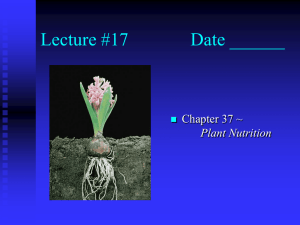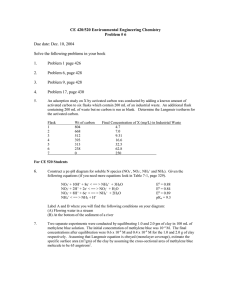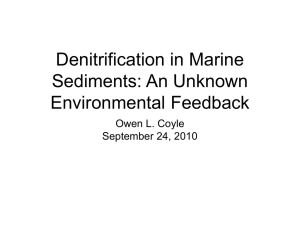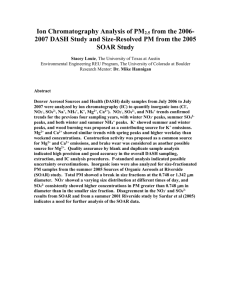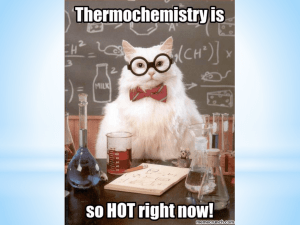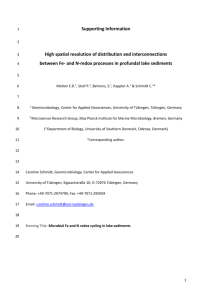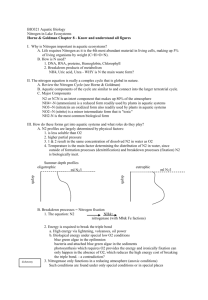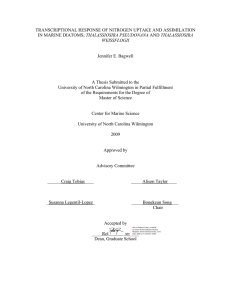Phytoplankton and primary production-2 Marine pelagic ecology BIO 4400 k
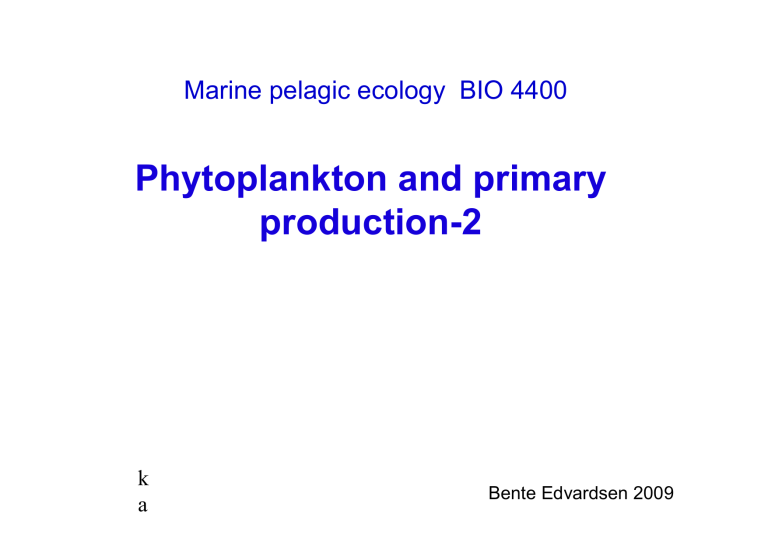
k a
Marine pelagic ecology BIO 4400
Phytoplankton and primary production-2
Bente Edvardsen 2009
Content
1.
Nutrients (N, P and Si)
2.
Growth
3.
Effects of temperature and salinity for growth
4.
Methods to measure primary production and algal biomass
Elemental composition of algal cells
99% of the living biomass is made up of C, H, O and N
Nutrients needed by algal cells
• Macronutrients : N, P, Si, S, K, Na
• Micronutrients: Fe, Zn, Cu, Mn, Se
• Vitamins: B
12
, biotin, thiamine
• In most marine environments algal growth is limited by N or P. The absolute levels are low, the demand high and concentrations very variable.
• But trace elements (e.g. Fe) may limit growth in some areas
HNLC
Parts of the Pacific and the Southern Ocean have areas with high nutrient and low chlorophyll levels where iron limit the growth
Nitrogen uptake in the algal cell
Uptake of [NO
3
] as a function of [NH
4
+ ]
Ammonium is preferred by phytoplankton at [NH4+] >1-2
µM
Enzyme nitrate reductase
( NR ) inhibited by [NH4+] >2
µM and is induced
Nitrogen cycle in the sea
Some N2 fixing cyanobacteria
Chemoautotrophic bacteria
After Paasche 2005
Anaerobic bacteria
Nitrogen cycle in the sea
Arrigo, K.R. 2005.
Nature 437: 349-355
Changes in [NO
3
] and [NH
4
+
Oslofjord (0-4 m depth)
] in the inner
From deep water from land
Paasche 2005
[NO
3
] and [NH
4
+ ] and particular N in the inner Oslofjord
(0-8 m depth)
Paasche 2005
short
Short and long cycle of N
Recycled production long
New production
New and recycled production ffactor = production based on NO
3
-
_______________________________ production based on NH
4
+ + NO
3
+ urea
Can be determined by a N 15 -method , but not well in coastal waters with supply of both NH
4
+ + NO
3
from land
Average f-factor is ~0.3 globally and ~0.5 in coastal waters
Phosphorus cycle
Paasche 2005
Phosphorus (P)
Phosphorus is rapidly remineralized to ortophosphate
Can be stored in cell
(polyphosphate, luxury uptake)
May limit production when fresh water influence is high
Paasche 2005
Elemental composition of algal cells
Silicate
Redfield ratio
• Albert Redfield noticed that elemental composition of plankton is strikingly similar to that in the deep ocean
• Nitrate:phosphate ratio 16:1 in the sea is controlled by the requirements of phytoplankton
• ..which subsequently release N and P to the environment at this ratio when remineralized
Redfield ratio
C:N:P : 106:16:1 = Redfield ratio
= average content in phytoplankton
Primary production:
106 CO
2
->
+ 16 NO
3
+ HPO
4
2+ 122H
2
O + 18 H +
C
106
H
263
O
110
N
16
P + 138 O
2
Nitrogen limitation in the sea
Mediterranean
NO 3+ / PO
4
3-
<16 in deep water support nitrogen limitation
Falkowski & Raven 1997.
Aquatic photosynthesis
Global balance between N
2 fixation and denitrification and anammox
Arrigo, K.R. 2005.
Nature 437: 349-355
Uptake rate (V) as a function of nutrient concentration (S)
Nutrient limitation
Michaelis-Menten
V = V max
.
S / (K s
+S)
No nutrient limitation
The affinity for a substrate increases with decreasing concentration
Photosynthesis and effect of temperature
Photosynthesis decrease with decreasing temperatures
The metabolic rate (enzymatic reactions) increase with temperature
From photosynthesis to growth
Respiration
• All organisms carry out respiration
• When oxygen is present :
6 O
2
+ C
6
H
12
O
6
-> 6CO
2
+ 6H
2
O + ATP
(energy)
• Anaerobic respiration :
• NO
3
, SO
4
2, CO
3
as electron donors or organic compounds
Growth curves- exponential growth
Most phytoplankton grow by two-division
Exponential growth
Population growth : nett growth rate (r) = growth rate (
μ
) – loss rate (
λ
) dN =
μ
N
0 dt
N = number of ind. in population
N t
= N
0 e
μ t
μ
= ln (N t
/N
0
) / t exponential growth
µ = specific growth rate (d -1 ) k = growth rate (divisions d -1 ) ln 2 = 0.69
k = 1.44
.
µ (or k= µ/ 0.69)
Maximal growth rate in response to temperature
Eppleys curve
• Eppleys curve: maximal growth rate at a given T
• Cold water species grow slowly
Growth rate as a function of salinity
Growth rate
(divisions/day)
Cell size and growth rate
Small cells growth faster than large
Growth rate and cell size diatome Diatomes: higher
Chl a: C -ratio
Dino: higher respiration, Ic dinoflagellate
